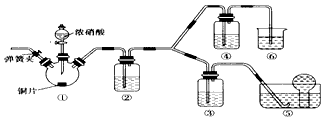某学习小组探究浓、稀硝酸氧化性的相对强弱,按下图装置进行实验(夹持仪器已略去)。实验表明浓硝酸能将NO氧化成NO2,而稀硝酸不能氧化NO。由此得出的结论是浓硝酸的氧化性强于稀硝酸。 可选药品:浓硝酸、3 mol/L稀硝酸、蒸馏水、浓硫酸、氢氧化钠溶液及二氧化碳 已知:氢氧化钠溶液不与NO反应,能与NO2反应。

2NO2 +2NaOH =NaNO3+ NaNO2+ H2O
(1)实验应避免有害气体排放到空气中。装置③、④、⑥中盛放的药品依次是__________________
(2)滴加浓硝酸之前的操作是检验装置的气密性,加入药品,打开弹簧夹后_____________________
(3)装置①中发生反应的化学方程式是_________________________ 。
(4)装置②的作用是____ ,发生反应的化学方程式是___________________________
(5)该小组得出的结论所依据的实验现象是______________________ 。
(6)实验结束后,同学们发现装置①中溶液呈绿色,而不显蓝色。甲同学认为是该溶液中硝酸铜的质量分数较高所致,而乙同学认为是该溶液中溶解了生成的 气体。同学们分别设计了以下4个实验来判断两种看法是否正确。这些方案中可行的是(选填序号字母)____。
a.加热该绿色溶液,观察颜色变化
b.加水稀释该绿色溶液,观察颜色变化
c.向该绿色溶液中通人氮气,观察颜色变化
d.向饱和硝酸铜溶液中通入浓硝酸与铜反应产生的气体,观察颜色变化
(1)3 mol/L稀硝酸、浓硝酸、氢氧化钠溶液
(2)通入CO2 一段时间,关闭弹簧夹,将装置⑤中导管末端伸入倒置的烧瓶内
(3)Cu +4HNO3(浓)=Cu(NO3)2 +2NO2↑ +2H2O
(4)将NO2转化为NO;3NO2 +H2O===2HNO3+NO
(5)装置③中液面上方气体仍为无色,装置④中液面上方气体由无色变为红棕色
(6) acd
